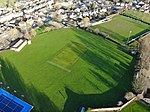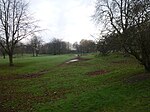Bourne Grammar School
1921 establishments in EnglandAcademies in LincolnshireAll pages needing cleanupBourne, LincolnshireEducational institutions established in 1921 ... and 3 more
Grammar schools in LincolnshirePeople educated at Bourne Grammar SchoolUse British English from February 2023
Bourne Grammar School (BGS) is a co-educational grammar school with academy status on South Road (A15), in Bourne, Lincolnshire, England. The school was founded in 1330. It previously held Arts College Status, and was awarded Academy status in January 2012, although it retains its former name.
Excerpt from the Wikipedia article Bourne Grammar School (License: CC BY-SA 3.0, Authors).Bourne Grammar School
South Road, South Kesteven Bourne
Geographical coordinates (GPS) Address Phone number Website External links Nearby Places Show on map
Geographical coordinates (GPS)
| Latitude | Longitude |
|---|---|
| N 52.76246 ° | E -0.37334 ° |
Address
Bourne Grammar School
South Road
PE10 9JE South Kesteven, Bourne
England, United Kingdom
Open on Google Maps










